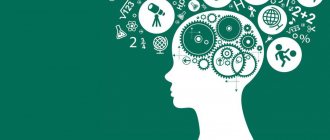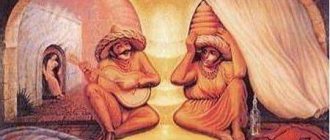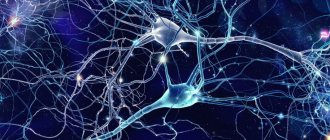Mental processes are a group of mental phenomena that are united by their functions in the structure of the individual’s psyche. The identification of mental processes is conditional. In fact, all mental processes are interconnected and cannot exist and function without each other. All mental processes take part in one large, most important process, which is called the human psyche. Scientists still divide the psyche into mental processes purely for pedagogical purposes, for ease of perception, although integral approaches to the study of the psyche have long dominated in science.
All mental processes are divided into:
- cognitive (sensation, perception, thinking, ideas, speech, attention, memory, imagination)
- emotional (emotions, feelings, affects, stress)
- volitional (struggle of motives, decision making, goal setting)
Are you an expert in this subject area? We invite you to become the author of the Directory Working Conditions
Interaction of perception and memory
The process of human perception of the world around us is not without trace. The images are fixed, saved and reproduced in the future. If a conscious person perceives some objects that he has seen before, then this process is based on recognition. Memory plays a big role in this process.
If for some reason a person stops remembering or forgets the necessary information received during life, then a disturbance in the perception of the world occurs, the person’s conscious life is disrupted, in fact, life collapses.
Note 1
Perception is inextricably linked to human experience. Experience arises in our minds from memories.
Abstract on the academic discipline “Psychology”
on the topic: “Sensation, perception, representation”
Plan
1. Introduction.
2. The concept of sensation, types, physiological basis of sensations.
3. The concept of perception, types, physiological basis of perception.
4. The concept of representation, types, physiological basis of representation.
5. Conclusion.
6. List of references.
1. Introduction.
The reconstruction of reality in the human mind begins with sensations that manifest themselves when the corresponding stimuli act on the receptors of the analyzers.
A person realizes himself in activities that are possible as a result of his knowledge of the environment. The leading role in a person’s interaction with the world around him is the properties of the individual, his attitudes, and motives. Also, all mental phenomena are a reflection of reality, a component of the regulation of activity. The regulation of activity begins at the level of perception and sensation - with mental cognitive processes.
Sensations, ideas, perceptions belong to sensory forms of cognition. Sensory reflection in humans is invariably associated with thinking and logical cognition. The individual in human sensory cognition is reflected in the expression of the general. In sensory cognition, a particularly important role is played by the word and language, which initially perform the function of generalization. Also, logical cognition is carried out on indicators of sensory experience, on perception, sensations, ideas, memory.
In the general process of cognition, there is a continuous interaction of all cognitive processes. Sensations are the basis for the most complex cognitive processes - representation, perception, imagination, thinking, memory.
Therefore, only through sensations can we become aware of any form of movement. Sensation is the simplest mental process, which is no longer divided. Sensations convey the strength of stimuli affecting a person and the objective qualities of an object.
2. The concept of sensation, types, physiological basis of sensations.
Sensation is the construction of images of separate properties of environmental objects in the process of natural interaction with them.
The sensory organization of personality is the norm for the development of separate systems of sensitivity and the potential for their unification. Sensory systems are human sensory organs that receive his sensations, in which sensations are replaced by perception. An important feature of the sensory organization of the personality is its formation throughout the entire life course. Sensitivity is given to a person from birth, but its development depends on the desire, circumstances and efforts of the individual himself.
Sensation is a general biological feature of living matter - sensitivity. Sensation is also a conductor of psychic communication with the inner and outer world. Information about all manifestations of the external world is supplied to the brain through sensations. In a similar way, through sensations, a loop is closed that receives feedback about the ongoing state of the body, both physical and, partly, mental. With the help of sensations, a person learns about movement, taste, color, smell, sound, and the state of his internal organs. From these sensations a complete perception of objects and the world is formed. The primary cognitive process takes place in the sensory systems of the individual, and on its basis the most complex cognitive processes are created: ideas, thinking, perceptions, memory. The primary cognitive process is simple, and at the same time, it is actually the basis of mental activity; only through the “inputs” of sensory systems is the essence of the surrounding world directed into human consciousness.
After the brain has received information, the result of its processing is the development of a response strategy, which is aimed, for example, at increasing physical tone, increasing concentration on a given activity, and setting the mood for an early entry into mental activity. In general, a counter action or a developed strategy at each moment in time is the best choice from the various options that are available to the individual at the moment when he makes a decision. But it is also clear that the number of available options and the quality of choice vary for different individuals and depend, for example, on: - mental properties of the individual; - partly physical condition; — strategies for relationships with the environment; — level of formation and organization of higher nervous processes; — experience, the existence of the required information in memory, the likelihood of its retrieval.
The physiological mechanism of sensations is the activity of nervous apparatus - analyzers. Analyzers are divided into three parts: receptor - the part of the analyzer that perceives and converts; the central part of the analyzer (conducted or sensitive nerves); cortical parts of the analyzer, processing nerve impulses. Each receptor corresponds to its own area of cortical cells. The specialization of any sense organs is built not only on the individuality of the construction of analyzer-receptors, but also on the specialization of neurons included in the group of central nervous apparatuses to which signals received by the peripheral sense organs are received. The analyzer is an active receiver of energy; it instinctively changes under the influence of stimuli.
The sensation can be described using several characteristic features. The main features of sensations are quality, duration, intensity, spatial localization.
Quality is a peculiar feature of this sensation, which distinguishes it from other forms of sensations and is modified within a certain type.
The qualities of the visual modality are saturation, hue, brightness.
The qualities of auditory sensations include pitch, timbre, and volume.
The qualities of tactile sensations include roughness, hardness, etc.
Particularly widespread is the classification of sensations by type (modality) of stimulus. Modality is a qualitative characteristic in which the originality of sensation as the simplest mental signal is manifested, which distinguishes it from a nervous signal.
Based on the constellation of receptors, sensations are divided into three groups. The first group is sensations associated with receptors that are located on the surface of the body: taste, visual, olfactory, auditory, skin - exteroceptive sensations. The second group is interoceptive sensations, they are associated with receptors that are located in the internal organs. The third group is static and kinesthetic sensations, their receptors are located in ligaments, tendons, and muscles - proprioceptive sensations.
Sensations are distinguished according to the modality of the analyzer. Distant - visual, auditory, and contact - these are taste and tactile sensations.
Each receptor responds to a specific type of stimulus. The following types of sensations are distinguished: - visual, which arise under the influence of light rays on the retina of the eye; - auditory, which arise as a result of the creation of sound waves of music, noise, speech; - vibrational - this is the ability to capture vibrations of an elastic medium - air, water, earth, objects, this is one of the types of auditory sensitivity, in humans it is poorly developed, but is used by bats, dolphins - ultrasound, echolocation; - olfactory - sensations that convey the smells of surrounding objects; - taste; - skin - this is a sensation of touch, pain, temperature.
Palms, fingertips and lips are very sensitive to touch; a person uses them to feel. Painful sensations that have a strong emotional connotation are clearly visible and audible to another person. Sensitivity to temperature is different; sensations are different in each part of the body: the back is more sensitive to cold than the chest. Depending on the state of the human body and psyche, pseudo-false sensations arise, i.e. hallucinations - there is no stimulus, but the sensation is present - a mirage, visions, delirium, voices, etc.
Proprioceptive sensitivity. Kinesthetic sensations are the sensation of movement and position of individual parts of the body. Receptors for kinesthetic sensations are located in tendons and muscles. Irritation in these receptors occurs due to the influence of muscle contraction and stretching.
Most of the motor receptors are located in the fingers, lips and tongue, because these organs are necessary for the implementation of precise and subtle working and speech movements. The work of the kinesthetic analyzer contributes to the coordination and control of one’s movements.
Speech sensations are formed from infancy to school age. When learning a foreign language, you need to develop speech sensations that are unusual in your native language.
Vestibular sense. Gravitational, or static, sensitivity conveys the position of the human body in space. Its receptors are located in the vestibular apparatus of the inner ear: the vestibular saccules and semicircular sacs, convert signals about gravity and relative movement, and send them to the temporal cortex and the cerebellum. Frequent and sharp changes in body position relative to the plane of the earth - sea motion, swinging - dizziness occurs - seasickness.
3. The concept of perception, types, physiological basis of perception.
Perception is the process of forming, through active actions, a subjective image of a holistic object that directly affects analyzers.
As studies by psychophysiologists show, perception is a complex process that requires extensive analytical and synthetic work. Therefore, it would be more accurate to describe perception as the perceiving activity of a person. The result of this activity is a holistic understanding of the subject that a person encounters in everyday life.
Significant in perception is the desire to perceive an object, awareness of the obligation or need to perceive it, volitional efforts that are aimed at improving perception, the persistence that a person shows in these cases. Consequently, orientation, in this case desire, and attention are involved in the perception of an object in the real world.
The physiological basis of perception is made up of processes that take place in nerve fibers, the central nervous system, and sensory organs. Under the influence of stimuli at the endings of the nerves that are present in the sensory organs, nervous excitation occurs, along the conductive paths it is directed to the nerve centers and, as a result, to the cerebral cortex. In the cerebral cortex, excitation enters the projection, or sensory, zones of the cortex, which are the central projection of the nerve endings that are present in the sense organs. Next, certain sensory information is formed, which depends on the connection of the projection zone with any organ.
The mechanism for the occurrence of sensations is the mechanism discussed above. The formation of sensations actually occurs at the level of the considered scheme. Thus, sensations can be considered as a structural element of the process of perception. Physiological mechanisms of perception enter into the process of creating a holistic image at the stages when excitation from the projection zones is transferred to the integrative zones of the cerebral cortex, where the creation of images of real world phenomena is completed. Therefore, the integrative zones of the cerebral cortex, which complete the process of perception, are often called perceptual zones. The function of perceptual zones has significant differences from the functions of projection zones.
The close connection of perception with emotional experiences, various thought processes, and motor activity further complicates its physiological basis. In view of this, nervous excitations that are caused by external stimuli begin in the sense organs, are redirected to the nerve centers and cover various areas of the cortex, and interact with other nervous excitations. All these lines of excitation, which interact with each other, widely cover different zones of the cortex, and represent the physiological basis of perception.
Temporary nerve connections that ensure the process of perception are presented in two types: inter-analyzer and formed within the same analyzer. The first type occurs when a complex stimulus of a single modality influences the body. Nervous connections are based in response to stimuli and their relationship - temporal, spatial. As a result, a process of unification—complex synthesis—occurs in the cerebral cortex.
The second type of nerve connections that are formed under the influence of a complex stimulus are connections within various analyzers. Sechenov I.M. explained their occurrence by the presence of associations - visual, motor, tactile, etc. Associations are necessarily accompanied by auditory images of words, with the help of which perception acquires a holistic character. Consequently, the foundation of the complex process of building a perception image is the system of intra-analyzer and inter-analyzer connections, which contribute to improving the conditions for seeing stimuli and taking into account the interaction of the properties of an object as a complex whole.
The main properties of perception are integrity, apperception, objectivity, structure, activity, constancy, meaningfulness.
Objectivity of perception is the ability to display phenomena and objects of the real world in the form of separate objects. In addition, objectivity is not an innate property of perception; the formation and improvement of this property occurs in the process of ontogenesis - from the first year of a child’s life.
Integrity. Sensation reflects the individual properties of an object, while perception, on the contrary, contributes to the creation of a holistic image of the object. It is based on the generalization of information received in the form of different sensations about the partial properties and qualities of an object. The components of sensation are so strong among themselves that a single complex image of an object is created even with the direct action of only individual properties or individual parts of the object. The emergence of this object occurs conditionally through connections between various sensations.
The integrity of perception is also associated with its structure. This feature lies in the fact that perception is largely not a projection of a person’s instantaneous sensations and is not their simple sum. A person perceives a generalized structure, practically abstracted from these sensations, the formation of which takes some time.
The next property of perception is constancy. Constancy is the relative constancy of certain properties of objects when the conditions of their perception change. With the help of the property of constancy, which manifests itself in the praxis of the perceptual system of compensating changes in the conditions of perception, a person perceives the objects around him as relatively constant. To a large extent, constancy is noticeable in the visual perception of shape, size of objects, and color. Thus, the constancy of color perception is contained in the relative constancy of visible color when lighting changes.
Also, perception is determined by the subject himself. What is perceived is not the ear and the eye, but a specific living person. Therefore, perception always reflects the characteristics of a person’s personality. The conditioning of perception from the general content of a person’s mental life is called apperception.
The manifestation of distorted or erroneous (false) perception is an illusion of perception. Illusions are observed in various types of perception - visual, auditory, etc. The characteristics of illusions are recognized by subjective reasons - direction, attitude, emotional attitude, as well as by physical phenomena and factors - position in space, illumination, etc.
Another property of perception is its meaningfulness. Perception is created through the direct action of a stimulus on the senses, and perceptual images always carry a certain semantic meaning. Human perception is closely related to thinking. The connection between perception and thinking is manifested in the conscious perception of an object, i.e. mentally name it - assign it to a certain class, group, associate it with a certain word. Even when examining an unfamiliar object, a person tries to determine its similarity with other objects.
At the basis of one of the classifications of perception are differences in the analyzers that take part in perception. Depending on which analyzer plays the most important role in perception, auditory, visual, kinesthetic, tactile, olfactory, and taste perception are distinguished.
As a rule, perception is the result of the interaction of a number of analyzers. Kinesthetic sensations are involved to varying degrees in all kinds of perception, for example, tactile - the participation of tactile and kinesthetic analyzers is observed. Also in visual and auditory perception, the participation of the kinesthetic analyzer is observed. Various types of perception are quite rarely found in their pure form. As a rule, they are combined, and as a result complex types of perception are created.
Another classification of types of perception is based on the forms of presence of matter: movement, space and time. In connection with this classification, the perception of movement, the perception of space and the perception of time are distinguished.
4. The concept of representation, types, physiological basis of representation.
A representation is a visual image of an object that is reproduced in the imagination from memory. Images of ideas are not as vivid and detailed as compared to images of perception, but they reflect the representativeness of a given object.
Representations are specific images of phenomena of the external world, objects, their properties, previously perceived by a person and then arising in his memory. The basis of ideas is a person’s previous experience - every idea is, in its different parts, perception.
Images of perception invariably have a visual nature: they reflect the external properties of phenomena and objects when they impact the human senses. Like perceptions, ideas are visual in nature, reflecting the external properties of objects that a person has known in previous experience.
But there are some differences between perception and representation.
Representations are images of phenomena and objects that are stored in a person’s memory; in their absence, phenomena and objects do not directly affect the senses;
Ideas are not as bright and clear as perceptions, for example, the idea of a tree you have ever seen is paler than its perception - it is less distinct in its size, shape, details, colors.
Representations are characterized by variability - the shape, color, and size of the represented object change freely. A person can imagine a red pencil with a round handle that he has just seen as a blue hexagonal one.
Representations, in comparison with perceptions, are more generalized images of objects, in which similar features of objects of this class play a primary role. For example, when a person needs to imagine a poplar, and not a cedar, his idea reflects the features of the bark, trunk, and leaf shape corresponding to the poplar. This is a generalized and at the same time visual image of a poplar, an image of not just any tree, but a poplar. Sometimes, if necessary, a single object is displayed in the representation, but the larger number of representations that a person has in his mind, as a rule, are generalized visual images of reality.
The physiological basis of ideas are processes that occur only in the cortical parts of the analyzers; receptors do not function during imagination.
At the basis of representation lies the perception of objects that existed in the past. There are several types:
- representations of memory - arising on the basis of the perception in the past of some phenomenon or object;
- representations of the imagination.
Representations characterize:
- visibility - sensual visual images of reality, this reveals the content of their similarity with images of perception;
- fragmentation - representations have gaps, some features and parts are presented very vaguely, others - clearly, and in the third case their absence is observed;
- impermanence and instability - any evoked image, object or someone’s image will be erased from consciousness, even if a person tries to save it.
Representations are not only visual images of reality, but more often generalized images, and this is their similarity in concepts.
Representation, like any other cognitive processes, performs certain functions in the regulation of human mental behavior. Researchers identify three important functions: regulatory, tuning and signaling.
The essence of the signal function of representations is the reflection of the image of an object, which until this moment influenced the human senses, as well as various information about this object, which is transformed under the influence of specific influences into a system of signals that are responsible for behavior.
The regulatory function of ideas is closely related to their signaling function and is located in the selection of the necessary information about a phenomenon or object that previously influenced the human senses. In this case, the choice is not made in the abstract; the real conditions of the intended activity are taken into account. With the help of the regulatory function, precisely those aspects, for example, of motor ideas are updated, on the basis of which the established task is resolved with great success.
Adjustment function - manifests itself in the orientation of human activity determined by the nature of the influence of the environment. The tuning function of representations is responsible for providing a certain training effect to motor representations, which contributes to the formation of the algorithm of our activity.
Typically, auditory, visual, kinesthetic, olfactory, tactile, gustatory, organic and temperature types of representations are distinguished.
Also, all ideas are different in the range of manifestations of volitional efforts.
Involuntary ideas are created spontaneously, without activating a person’s memory.
Arbitrary ideas are created in a person with volitional effort, in orientation towards a set goal.
Representations are the most important form of subjective reflection of the objective world. They represent the most important value in human activity and life. If there are no ideas, then the contents of his consciousness would be limited only by existing perceptions; there would be a reflection of the images of objects directly acting on him at each current moment.
With the help of the generalization links they contain, ideas serve as an intermediate step from sensations to thinking, from concrete images to abstract concepts.
Also, with the help of their inherent wide variability, which allows for the construction of new images, ideas play a necessary and significant role in human creative activity.
5. Conclusion.
The most important role of sensations is to quickly and timely convey to the central nervous system, as the main organ of activity control, information about the state of the internal and external environment, the presence of biologically important factors in it.
Human life is multifaceted and complex. Its manifestation is visible through a significant chain of important processes. Conventionally, they are divided into business and social activity, medicine, culture, sports, interpersonal relationships, communication, research and scientific activities, recreation and entertainment.
Thus:
- sensation is a reflection of the individual properties of objects that affect the senses;
- perception is a very complex, and at the same time unified process, which is aimed at knowing what currently has an impact on a person;
- representation is a mental process of reflecting objects, phenomena that are not currently perceived, but are recreated on the basis of a person’s previous experience.
The full course of the above processes is problematic and sometimes even impossible to imagine without the participation of all human senses. Therefore, it is necessary to assess the role of feelings in a person’s life, since sometimes this information helps in organizing the successful existence of an individual in society and achieving success in a business environment.
6. List of references.
1. L.S. Vygotsky, Psychology. – M.: EKSMO-Press, 2000. – 1008 p.
2. S.L. Rubinstein, Fundamentals of general psychology [Text] / S.L. Rubinstein. - St. Petersburg; Peter, 2007. – 713 p. – (Series “Masters of Psychology”).
3. A.N. Leontiev, Lectures on general psychology. – M.: Meaning; Ed. , 2007. – 511 p.
4. N.Yu. Dmitrieva, General psychology. Lecture notes. – M.: Eksmo, 2007. – 128 p.
5. M.A. Lukatsky, M.E. Ostrenkova, Psychology. – M.: Eksmo, 2007. – 416 p.
Interaction of perception, speech and thinking
The process of decoding a speech code is possible if three conditions are met:
- a person perceives and understands individual words
- a person understands sentence structure
- the person understands the entire message
Finished works on a similar topic
Course work Integration of mental processes 400 ₽ Essay Integration of mental processes 220 ₽ Test work Integration of mental processes 220 ₽
Receive completed work or specialist advice on your educational project Find out the cost
Based on the understanding of each semantic unit, a person makes an inference about the meaning, then about the connections between the units of meaning, then the meaning is formulated, that is, a generalization of the result of the mental work done. At the end, the listener has the general meaning of the message he heard.
These processes can be described differently by a system of levels. There are six main levels in total.
- primary synthesis - analysis - secondary synthesis;
- perception - recognition - understanding;
- phonemic - morphemic - verbal - phrasal;
- recognition - intelligibility - semantic perception;
- phonetic - phonemic - grammatical - semantic-semantic;
- auditory sensation - perception - conceptual
Mental operations
The main mental operations are distinguished:
- analysis,
- comparison,
- synthesis,
- generalization
- abstraction , etc.
► Analysis is a mental operation of dividing a complex object into its constituent parts or characteristics.
► Comparison is a mental operation based on establishing similarities and differences between objects.
► Synthesis is a mental operation that allows one to mentally move from parts to the whole in a single process.
► Generalization is the mental unification of objects and phenomena according to their common and essential characteristics.
► Abstraction (distraction) is a mental operation based on highlighting the essential properties and connections of an object and abstracting from other, unimportant ones.
Interaction of thinking and imagination
Imagination has a number of characteristics:
- appears at the moment of a certain task
- motives and needs play an important role
- determined by the level of social consciousness
Certain theoretical ideas and thoughts very often appear in the imagination. For example, a writer who writes a work or an artist who paints a picture with the help of images wants to convey his thoughts.
Scientists have repeatedly mentioned that the development of imagination takes place only with a well-developed intellect.
Note 2
Thinking and imagination are on the same level and are the highest thought processes.
Imagination and thinking interact, as a result of which imagination can take on the function of thinking, thereby a person can carry out the process of understanding and cognition.
There are three main connections between thinking and imagination:
- imagination “carries” thinking beyond the perceived
- when imagination and thinking interact, the future is anticipated
- this relationship helps to remember previous experiences.
Fantasy as a creative process
Fantasy - (Greek tsbnfbuYab - imagination) - a situation imagined by an individual or group that does not correspond to reality, but expresses their desires; an unreal combination of real elements; a dream, a product of the imagination. Fantasies can be of any nature.
There are active and passive fantasies; the former are caused by intuition, that is, an attitude aimed at the perception of unconscious contents, and libido immediately occupies all elements emerging from the unconscious and brings them, through the association of parallel materials, to complete clarity and visibility; passive fantasies appear immediately in a visual form, without a preceding or accompanying intuitive attitude, with a completely passive attitude of the cognizing subject. Such fantasies belong to mental “automatisms”. Passive fantasy always arises from some process in the unconscious; active fantasy owes its existence to the participation of consciousness.
With the help of fantasy, a person can get used not only to the images of other people, but also to any images of objects and phenomena, transforming their nature. These can be images of living beings, then a person endows them with human traits, personifies them. This is what a fabulist does, for example. If objects are images of inanimate objects, then fantasy can give them the appearance of animate beings.
The very nature of creative activity, which reveals something new and unknown, presupposes the desire to look into the future and anticipate the result of the activity. This is what fantasy does, performing a prognostic function. The motives of fantasy, in principle, coincide with the motives of creative activity. First of all, this is the need for search activity, the desire for novelty, the unusual, the unpredictable. Another motive for fantasy is often unsatisfied desires of various kinds. The motive of self-expression, the desire to assert one’s personality, is also essential.
Creative imagination is original, independent, active and purposeful. Other types of fantasy - dreams, daydreams, recreating fantasy (according to the description) are characterized by passivity and whimsicality. This is, for example, the fantasy of viewers and listeners of a work of art.
When imagining, the child himself creates any plot he wants, including a fairy tale, any situation he wants, any problem he wants, and solves it himself in any way he wants. Any solution is acceptable. And when solving real problems, the child is looking not for any solution, but for a real, “adult”, serious, feasible solution. In both cases, he creates, but with fantasy there is more freedom, since there are no prohibitions from physical laws and much knowledge is not required. But the main thing is not to “overdo it” with fantasy, so that the fantasy does not become stupidity. Stupidity is an unnecessary, unreasonable, incorrect, harmful, inappropriate act or statement that does not bring honor to the one who committed it. Of course, one must take into account the person’s age, conditions and goals of the action.
The classic vehicle of fantasy is the fairy tale. What is the difference between a fairy tale and science fiction? In science fiction, technically feasible situations, elements or processes are considered, and in a fairy tale, any. It should be noted that there is also no sharp boundary between fantastic and real solutions. For example, what was considered fantasy in the time of Jules Verne is now everyday reality. G.A. Altshuller calculated that out of 108(!) ideas and forecasts of J. Verne, 99 (90%) were implemented. Herbert Wells has 77 out of 86, Alexander Belyaev has 47 out of 50 [Altshuller G.S. Human life 1-4-502 // TRIZ Magazine. -1996. — No. 2. - p.44-52; 1997. - N1. - p.4-15].
When a child selflessly tells fables with his own participation, he is not lying; in our usual understanding, he is composing. It doesn't matter to him whether it's real or not real. And this shouldn’t be important to us, what’s important is that the child’s brain works and generates ideas. However, you should still pay attention to what the child dreams of. If he talks all the time about his non-existent friends, about affectionate parents or about toys, then perhaps he suffers, dreams about it and thus pours out his soul.
Interaction of attention and memory
Without such important psychological processes as memory and attention, normal human life is practically impossible. These processes help to receive information from the outside world and retain it for a long time.
All human mental activity relies on memory. Memory helps us revive past experiences, knowledge, phenomena, images in our minds. The most dynamic development of memory occurs at school age.
The problem of interaction between memory and attention is one of the most pressing in modern psychology. How well a person remembers information depends on how attentive he is. Attention allows a person to successfully perform his work and control external conditions.
Note 3
It should be noted that when one of these functions decreases, the second also begins to suffer.
Interaction of memory and speech
Speech and memory are closely related. If memory and speech function properly, a person can share experiences and reproduce accumulated knowledge and skills. Speech is a mental process, the highest mental function that ensures communication between people. Memory, in turn, accumulates, stores, and then reproduces previously received information. It should be noted that it is speech and, along with it, memory that actively develops in preschool age.
It should be noted that speech is largely associated with logical memory. It is easier to remember what was expressed in linguistic form.
Speech helps sensory memory, which most often does not last long.
When a person perceives or generates speech, he turns to his memory. Without memory, a person would not be able to communicate, since he would not remember the meaning of words.
Interaction of imagination and perception
Since both the process of perception and the process of imagination begin their work in the brain, a situation may occur when one turns into the other. Perception gives the integrity of the object, the semantic characteristics of the object are broken. In the process of perception, images can become more complex. Imagination manifests itself when consciousness begins to complete images independently, regardless of external factors. A person, without seeing the full picture, can complete the missing parts. This ability indicates the development of objective-activity characteristics of sensory images. A person consciously produces missing images. Imagination develops in the human mind. This means that a person transfers his attitudes, motives and desires to the missing elements.
Get paid for your student work
Coursework, abstracts or other works
Ways to build new images
The transformation of reality in the imagination is carried out by methods; called "techniques" of imagination . These include:
Combination , the combination of data in the experience of elements in new, more or less unusual combinations. This is the simplest technique of imagination, and it is what researchers of the past had in mind when they considered associations to be the mechanism of imagination.
Agglutination, a combination option in which a non-random set of traits is subject to combination, undergoes a direct selection of them according to a specific plan, concept.
Accentuation , emphasizing certain features of a phenomenon, which transforms its overall appearance. It should highlight the characteristic, essential, important.
Hyperbole and litotes - Changes in magnitude, quantitative growth and decrease - are special options for emphasis (very large or very small in relation to reality are emphasized. When in the imagination there is immediately an increase in some sides and a decrease in others, we are talking about polarization.
Idealization , The construction of idealized images free from all petty things, which sometimes cause the illusion of exclusivity and perfection of a certain phenomenon. The main essence of dreams lies in the pursuit of ideal.
Typification , Specific generalization. Through the concrete in the image that appears to the type, the generally significant is highlighted.
Alegorization, Creation of allegory - the use of an image in a figurative sense. An image acts only as a conventionally chosen sign of some phenomenon of reality.
Metaphorization , Construction of metaphors. A metaphor is a deeper mental representation of a phenomenon than an allegory, since there is a certain similarity and analogy between the metaphorical image and its meaning.
Symbolization , the use of symbols, is the most profound, essential filling of the imagination technique. Understanding the language of symbols helps a person consciously receive messages from his own unconscious (dreams, etc.). A symbol differs from a sign in that it is not conventionally chosen to designate, but is deeply, essentially united with what it denotes. Unlike a concept, a symbol has an unlimited amount of meaning. Only the universal, due to the very way of human existence, can be expressed through symbols.
In the technique of imagination, a complex dynamic unity of the conscious and unconscious is always created.









